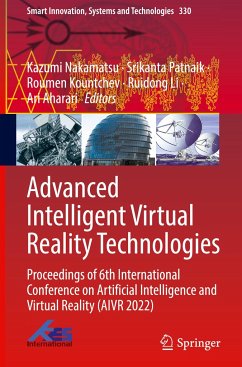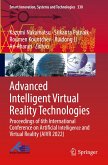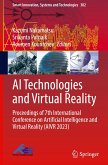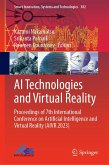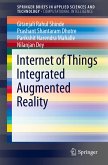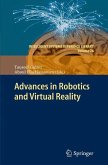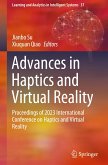Advanced Intelligent Virtual Reality Technologies
Proceedings of 6th International Conference on Artificial Intelligence and Virtual Reality (AIVR 2022)
Herausgegeben:Nakamatsu, Kazumi; Patnaik, Srikanta; Kountchev, Roumen; Li, Ruidong; Aharari, Ari
Advanced Intelligent Virtual Reality Technologies
Proceedings of 6th International Conference on Artificial Intelligence and Virtual Reality (AIVR 2022)
Herausgegeben:Nakamatsu, Kazumi; Patnaik, Srikanta; Kountchev, Roumen; Li, Ruidong; Aharari, Ari
- Gebundenes Buch
- Merkliste
- Auf die Merkliste
- Bewerten Bewerten
- Teilen
- Produkt teilen
- Produkterinnerung
- Produkterinnerung
This book gathers a collection of selected works and new research results of scholars and graduate students presented at the 6th International Conference on Artificial Intelligence and Virtual Reality (AIVR 2022) via the Internet, during July 22-24 2022, hosted and organized by Sojo University in conjunction with other three universities and Beijing Huaxia Rongzhi Blockchain Technology Institute. The focus of the book is interdisciplinary in nature and includes research on all aspects of artificial intelligence and virtual reality, from fundamental development to the applied system. The book…mehr
Andere Kunden interessierten sich auch für
![Advanced Intelligent Virtual Reality Technologies Advanced Intelligent Virtual Reality Technologies]() Advanced Intelligent Virtual Reality Technologies183,99 €
Advanced Intelligent Virtual Reality Technologies183,99 €![AI Technologies and Virtual Reality AI Technologies and Virtual Reality]() AI Technologies and Virtual Reality161,99 €
AI Technologies and Virtual Reality161,99 €![AI Technologies and Virtual Reality AI Technologies and Virtual Reality]() AI Technologies and Virtual Reality280,99 €
AI Technologies and Virtual Reality280,99 €![Internet of Things Integrated Augmented Reality Internet of Things Integrated Augmented Reality]() Gitanjali Rahul ShindeInternet of Things Integrated Augmented Reality37,99 €
Gitanjali Rahul ShindeInternet of Things Integrated Augmented Reality37,99 €![Advances in Robotics and Virtual Reality Advances in Robotics and Virtual Reality]() Advances in Robotics and Virtual Reality125,99 €
Advances in Robotics and Virtual Reality125,99 €![Advances in Robotics and Virtual Reality Advances in Robotics and Virtual Reality]() Advances in Robotics and Virtual Reality110,99 €
Advances in Robotics and Virtual Reality110,99 €![Advances in Haptics and Virtual Reality Advances in Haptics and Virtual Reality]() Advances in Haptics and Virtual Reality147,99 €
Advances in Haptics and Virtual Reality147,99 €-
-
-
This book gathers a collection of selected works and new research results of scholars and graduate students presented at the 6th International Conference on Artificial Intelligence and Virtual Reality (AIVR 2022) via the Internet, during July 22-24 2022, hosted and organized by Sojo University in conjunction with other three universities and Beijing Huaxia Rongzhi Blockchain Technology Institute. The focus of the book is interdisciplinary in nature and includes research on all aspects of artificial intelligence and virtual reality, from fundamental development to the applied system. The book covers topics such as system techniques, performance, and implementation; content creation and modelling; cognitive aspects, perception, user behaviour; AI technologies; interactions, interactive and responsive environments; AI/VR applications and case studies.
Produktdetails
- Produktdetails
- Smart Innovation, Systems and Technologies 330
- Verlag: Springer / Springer Nature Singapore / Springer, Berlin
- Artikelnr. des Verlages: 978-981-19-7741-1
- 1st edition 2023
- Seitenzahl: 268
- Erscheinungstermin: 20. Januar 2023
- Englisch
- Abmessung: 241mm x 160mm x 20mm
- Gewicht: 619g
- ISBN-13: 9789811977411
- ISBN-10: 9811977410
- Artikelnr.: 65889354
- Herstellerkennzeichnung Die Herstellerinformationen sind derzeit nicht verfügbar.
- Smart Innovation, Systems and Technologies 330
- Verlag: Springer / Springer Nature Singapore / Springer, Berlin
- Artikelnr. des Verlages: 978-981-19-7741-1
- 1st edition 2023
- Seitenzahl: 268
- Erscheinungstermin: 20. Januar 2023
- Englisch
- Abmessung: 241mm x 160mm x 20mm
- Gewicht: 619g
- ISBN-13: 9789811977411
- ISBN-10: 9811977410
- Artikelnr.: 65889354
- Herstellerkennzeichnung Die Herstellerinformationen sind derzeit nicht verfügbar.
Kazumi Nakamatsu received the Ms. Eng. and Dr. Sci. from Shizuoka University and Kyushu University, Japan, respectively. His research interests encompass various kinds of logic and their applications to Computer Science, especially paraconsistent annotated logic programs and their applications. He has developed some paraconsistent annotated logic programs called ALPSN (Annotated Logic Program with Strong Negation), VALPSN (Vector ALPSN), EVALPSN (Extended VALPSN) and bf-EVALPSN (before-after EVALPSN) recently, and applied them to various intelligent systems such as a safety verification based railway interlocking control system and process order control. He is an author of over 180 papers and 30 book chapters and 20 edited books published by prominent publishers. Kazumi Nakamatsu has chaired various international conferences, workshops, and invited sessions, and he has been a member of numerous international program committees of workshops and conferences in the area of Computer Science. He has served as the editor-in-chief of the International Journal of Reasoning-based Intelligent Systems(IJRIS); he is now the founding editor of IJRIS and an editorial board member of many international journals. He has contributed numerous invited lectures at international workshops, conferences, and academic organizations. He also is a recipient of numerous research paper awards. Dr. Srikanta Patnaik is presently working as the director of International Relation and Publication of SOA University. He is a full professor in the Department of Computer Science and Engineering, SOA University, Bhubaneswar, India. He has received his Ph. D. (Engineering) on Computational Intelligence from Jadavpur University, India, in 1999. He has supervised more than 25 Ph.D. theses and 60 master theses in the area of computational intelligence, machine learning, soft computing applications, and re-engineering. Dr. Patnaik has published around 100 research papers in international journals and conference proceedings. He is author of two textbooks and 52 edited volumes and few invited book chapters, published by leading international publisher like Springer-Verlag, Kluwer Academic, etc. Dr. Srikanta Patnaik is the editors-in-chief of International Journal of Information and Communication Technology and International Journal of Computational Vision and Robotics published from Inderscience Publishing House, England, and International Journal of Computational Intelligence in Control, published by MUK Publication, the editor of Journal of Information and Communication Convergence Engineering, and an associate editor of Journal of Intelligent and Fuzzy Systems (JIFS), which are all Scopus Index journals. He is also the editors-in-chief of Book Series on "Modeling and Optimization in Science and Technology" published from Springer, Germany, and Advances in Computer and Electrical Engineering (ACEE) and Advances in Medical Technologies and Clinical Practice(AMTCP), published by IGI Global, USA. Dr. Patnaik has travelled more than 20 countries across the globe to deliver invited talks and keynote address at various places. He is also a visiting professor to some of the universities in China, South Korea, and Malaysia. Prof. Roumen Kountchev Ph.D., D.Sc. is a professor at the Faculty of Telecommunications, Dept. of Radio Communications and Video Technologies, Technical University of Sofia, Bulgaria. His areas of interests are digital signal and image processing, image compression, multimedia watermarking, video communications, pattern recognition and neural networks. Prof. Kountchev has 350 papers published in magazines and proceedings of conferences; 20 books; 47 book chapters; and 21 patents. He had been a principle investigator of 38 research projects. At present, he is a member of Euro Mediterranean Academy of Arts and Sciences and President of Bulgarian Association for Pattern Recognition (member of Intern. Association for Pattern Recognition). He is an editorial board member of: Intern. J. of Reasoning-based Intelligent Systems; Intern. J. Broad Research in Artificial Intelligence and Neuroscience; KES Focus Group on Intelligent Decision Technologies; Egyptian Computer Science J.; Intern. J. of Bio-Medical Informatics and e-Health, and Intern. J. Intelligent Decision Technologies. He has been a plenary speaker at: WSEAS Intern. Conf. on Signal Processing, 2009, Istanbul, Turkey; WSEAS Intern. Conf. on Signal Processing, Robotics and Automation, University of Cambridge 2010, UK; WSEAS Intern. Conf. on Signal Processing, Computational Geometry and Artificial Vision 2012, Istanbul, Turkey; Intern. Workshop on Bioinformatics, Medical Informatics and e-Health 2013, Ain Shams University, Cairo, Egypt; Workshop SCCIBOV 2015, Djillali Liabes University, Sidi Bel Abbes, Algeria; Intern. Conf. on Information Technology 2015 and 2017, Al Zayatoonah University, Amman, Jordan; WSEAS European Conf. of Computer Science 2016, Rome, Italy; The 9th Intern. Conf. on Circuits, Systems and Signals, London, UK, 2017; IEEE Intern. Conf. on High Technology for Sustainable Development 2018 and 2019, Sofia, Bulgaria; The 8th Intern. Congress of Information and Communication Technology, Xiamen, China, 2018; General chair of the Intern. Workshop New Approaches for Multidimensional Signal Processing, July 2020, Sofia, Bulgaria. Assoc. Prof. Ruidong Li is an associate professor at Kanazawa University, Japan. Before joining this university, he was a senior researcher at the National Institute of Information and Communications Technology (NICT), Japan. He serves as the secretary of IEEE ComSoc Internet Technical Committee (ITC), is the founder and chair of IEEE SIG on Big Data Intelligent Networking and IEEE SIG on Intelligent Internet Edge, and the co-chair of young research group for Aisa future internet forum. He is the associate editor of IEEE Internet of Things Journal and also served as the guest editors for a set of prestigious magazines, transactions, and journals, such as IEEE communications magazine, IEEE network magazine, IEEE Trans. He also served as chairs for several conferences and workshops, such as the general co-chair for AIVR2019, IEEE INFOCOM 2019/2020/2021 ICCN workshop, IEEE MSN 2020, BRAINS 2020, IEEE ICDCS 2019/2020 NMIC workshop and IEEE Globecom 2019 ICSTO workshop, and publicity co-chair for INFOCOM 2021. His research interests include future networks, big data networking, intelligent Internet edge, Internet of things, network security, information-centric network, artificial intelligence, quantum Internet, cyber-physical system, naming and addressing schemes, name resolution systems, and wireless networks. He is a senior member of IEEE and a member of IEICE. Assoc. Prof. Ari AHARARI (PhD) received M.E. and Ph.D. in Industrial Science and Technology Engineering and Robotics from Niigata Universityand Kyushu Institute of Technology, Japan, in 2004 and 2007, respectively. In 2004, he joined GMD-JAPAN as a research assistant. He was a research scientist and coordinator at FAIS- Robotics Development Support Office from 2004 to 2007. He was a postdoctoral research fellow of the Japan Society for the Promotion of Science (JSPS) at Waseda University, Japan, from 2007 to 2008. He served as a senior researcher of Fukuoka IST involved in the Japan Cluster Project from 2008 to 2010. In 2010, he became an assistant professor at the faculty of Informatics of Nagasaki Institute of Applied Science. Since 2012, he has been an associate professor at the Department of Computer and Information Science, Sojo University, Japan. His research interests are IoT, robotics, IT agriculture, image processing and data analysis (Big Data) and their applications. He is a member of IEEE (Robotics and Automation Society), RSJ (Robotics Society of Japan), IEICE (Institute of Electronics, Information and Communication Engineers), and IIEEJ (Institute of Image Electronics Engineers of Japan).
Part 1: Invited Paper.- Chapter 1. Paraconsistency and Paracompleteness in AI: Review Paper.- Part 2: Regular Papers.- Chapter 2. Decision Support Multi-agent Modeling and Simulation of Aeronautic Marine Oil Spill Response.- Chapter 3. Transferring Dense Object Detection Models to Event-based Data.- Chapter 4. Diagnosing Parkinson's Disease Based on Voice Recordings: Comparative Study Using Machine Learning Techniques.- Chapter 5. Elements of Continuous Reassessment and Uncertainty Self-Awareness: A Narrow Implementation for Face and Facial Expression Recognition.- Chapter 6. Topic-aware Networks for Answer Selection.- Chapter 7. Design and Implementation of Multi_Scene Immersive Ancient Style Interaction System Based on Unreal Engine Platform.- Chapter 8. Auxiliary Figure Presentation Associated with Sweating on a Viewer's Hand in order to Reduce VR Sickness.- Chapter 9. Design and Implementation of Immersive Display Interactive System Based on New Virtual Reality.- Chapter 10. 360-Degree Virtual Reality Videos in EFL Teaching: Student Experiences.- Chapter 11. Research on Chinese Garden Art Appreciation Based on Virtual Technology.- Chapter 12. Medical-Network (Med-Net): A Neural Network for Breast Cancer Segmentation in Ultrasound Image.- Chapter 13. Auxiliary Squat Training Method Based on Object Tracking.- Chapter 14. Study on the Visualization Modeling of Aviation Emergency Rescue System Based on Systems Engineering.- Chapter 15. An AI-based System Offering Automatic DR-enhanced AR for Indoor Scenes.- Chapter 16. Extending Mirror Therapy into Mixed Reality - Design and Implementation of the application PhantomAR to alleviate phantom limb pain in upper limb amputees.- Chapter 17. An Analysis of Trends and Problems of Information Technology Application Research in China's Accounting Field based on CiteSpace.- Chapter 18. Augmented Reality Framework and Application for Aviation Emergency Rescue Based on Multi-Agent and Service.
Part 1: Invited Paper.- Chapter 1. Paraconsistency and Paracompleteness in AI: Review Paper.- Part 2: Regular Papers.- Chapter 2. Decision Support Multi-agent Modeling and Simulation of Aeronautic Marine Oil Spill Response.- Chapter 3. Transferring Dense Object Detection Models to Event-based Data.- Chapter 4. Diagnosing Parkinson's Disease Based on Voice Recordings: Comparative Study Using Machine Learning Techniques.- Chapter 5. Elements of Continuous Reassessment and Uncertainty Self-Awareness: A Narrow Implementation for Face and Facial Expression Recognition.- Chapter 6. Topic-aware Networks for Answer Selection.- Chapter 7. Design and Implementation of Multi_Scene Immersive Ancient Style Interaction System Based on Unreal Engine Platform.- Chapter 8. Auxiliary Figure Presentation Associated with Sweating on a Viewer's Hand in order to Reduce VR Sickness.- Chapter 9. Design and Implementation of Immersive Display Interactive System Based on New Virtual Reality.- Chapter 10. 360-Degree Virtual Reality Videos in EFL Teaching: Student Experiences.- Chapter 11. Research on Chinese Garden Art Appreciation Based on Virtual Technology.- Chapter 12. Medical-Network (Med-Net): A Neural Network for Breast Cancer Segmentation in Ultrasound Image.- Chapter 13. Auxiliary Squat Training Method Based on Object Tracking.- Chapter 14. Study on the Visualization Modeling of Aviation Emergency Rescue System Based on Systems Engineering.- Chapter 15. An AI-based System Offering Automatic DR-enhanced AR for Indoor Scenes.- Chapter 16. Extending Mirror Therapy into Mixed Reality - Design and Implementation of the application PhantomAR to alleviate phantom limb pain in upper limb amputees.- Chapter 17. An Analysis of Trends and Problems of Information Technology Application Research in China's Accounting Field based on CiteSpace.- Chapter 18. Augmented Reality Framework and Application for Aviation Emergency Rescue Based on Multi-Agent and Service.

